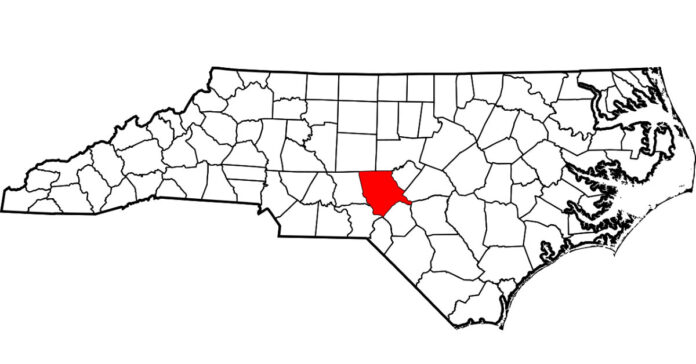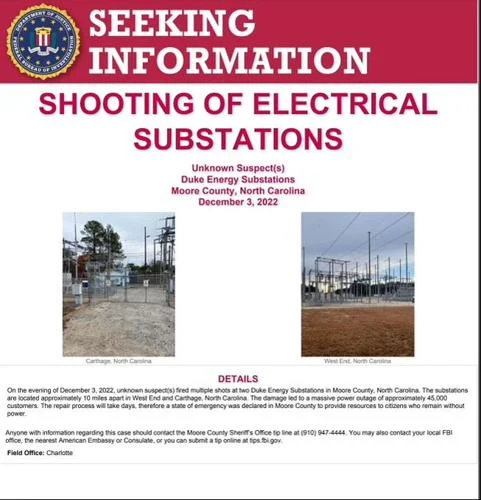
On Saturday evening, one or more unknown persons shot up two Duke Energy substations in North Carolina, knocking out power to approximately 45,000 customers in the area known as the Sandhills. This incident is so serious that the local and state police, the FBI, and Homeland Defense are all involved in the investigation. They have not yet labeled it domestic terrorism, but neither have they arrested anyone.
The latest news I have seen says power has been restored to all but 12,202 customers. It may be fully restored by the time you read this.
I don’t think we’re getting the whole story. I saw one article that included a photo of a gate to one substation that looks like it was run over or pulled out of the ground. Further, the governor said “violence and sabotage will not be tolerated.” That sounds like more than a simple shooting.

If Duke had to ship replacement parts in, the damage must have been pretty severe. How much damage can a few dozen bullets do? How much knowledge is required to know what parts of a substation should be shot to do the most damage?
Also, implementing a curfew seems a bit extreme. Did they really expect looting to break out immediately? Or are police and local officials just looking for an excuse to limit our freedoms?
We’ve Been Lucky
That our electrical infrastructure was attacked should surprise no one. The lax security at our substations and power distribution network is a known issue. I’ve read novels in which terrorists targeted the system. It has been in movies. We just live in a system where we wait until the problem manifests before we act; politicians and corporate CEOs don’t want to spend money on preventative systems and processes.
There are no cameras at these locations, so the local sheriff asked people in the area to check their doorbell and security cameras and turn in anything from that time frame. How hard would it be to install in a couple of cameras? Technology also exists that can identify gunfire picked up by a microphone. Why not install that? An AI could monitor it and report gunfire in the area around a substation. At the very least, this might have allowed law enforcement to act proactively and prevent the second attack, which took place about an hour later, even though the locations are just 10 miles apart.
This type of attack will happen again. You should be prepared for it.
No One Was Prepared
The local newspaper, The Pilot, reports that unlike when a hurricane is expected, the sudden blackout caught people unprepared. (Thus justifying the reason to prepare, because disasters and emergencies often strike out of the blue.) For an area that often sees hurricanes, it seems like few people have generators as the newspaper is filled with people complaining that they lost food. It doesn’t take a very large or expensive generator to run your refrigerator.
The affected residents are lucky that the outage is confined to a small area and that nearby counties are up and running. People are traveling out of town to shop at grocery and convenience stores that have power, to buy rotisserie chickens for dinner, to go to restaurants for a hot meal, and to buy ice. Many people have moved into hotels in neighboring counties.
What would these people do if they nothing was open for several hundred or even thousand miles? How long would there be fuel to run the generators that keep hospitals open, cell towers functioning, and the water and sewer pumps pumping in a national outage?
Are you Prepared?
This is a good time to assess your level of preparedness. What would you do if the power went out as you were sitting down for dinner and then you learned it might be a week or more before it went back on? Would you be able to prepare food and eat, keep warm, keep food refrigerated, have some lights, and keep yourself and any kids busy or entertained? If you’re a prepper, you should answer yes to these questions.
I’ve lived through a five-day power outage in a blizzard, and several other multi-day outages, most of which were caused by ice storms or high winds. In these situations, the weather was bad enough that we could not leave the house to buy ice, gas or food. Having a wood stove helped the most because it allowed us to cook food as well as provided lots of heat.
In extended power outages, we run the generator for a few hours in the morning and a few hours at night. We have four extensions cords coming from it: one to the refrigerator, one to the freezer, one to the kitchen for lights and small appliances, and one to the basement where it powers our cable modem, Wi-Fi router, and any entertainment systems. Our freezer is set to zero degrees, and using this approach, it warms up to about 20 before we run the generator again. It has never broached the freezing mark.
If you don’t have a wood stove but have a generator, here’s a video that illustrates how you can adapt your gas-powered furnace, which uses 110 volt electricity for the blower, to run on an extension cord from a generator or inverter. It looks good to me and could be a big help during the colder months. I’ve never tried this because I don’t have a gas furnace, so if you try this, you do so it at your own risk.







